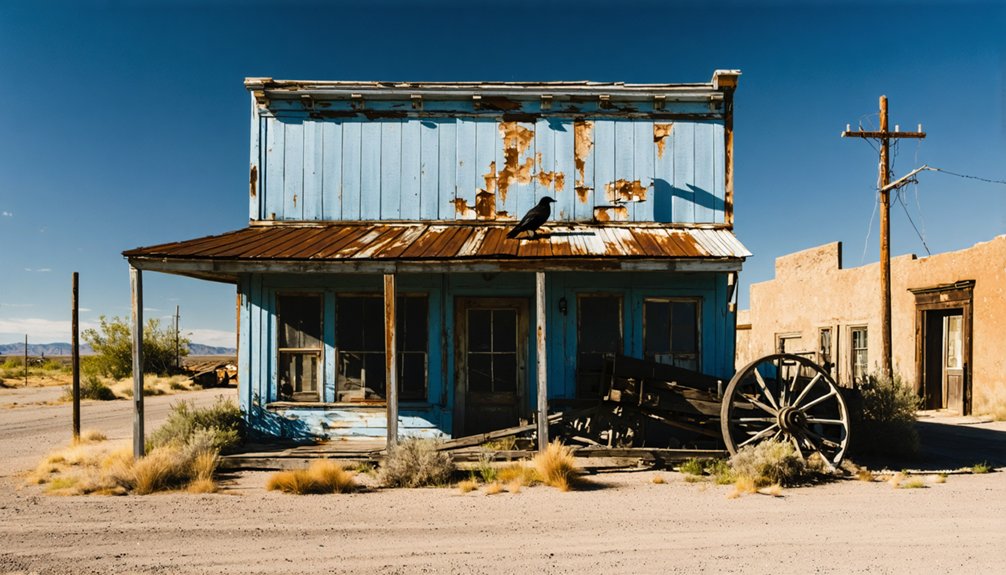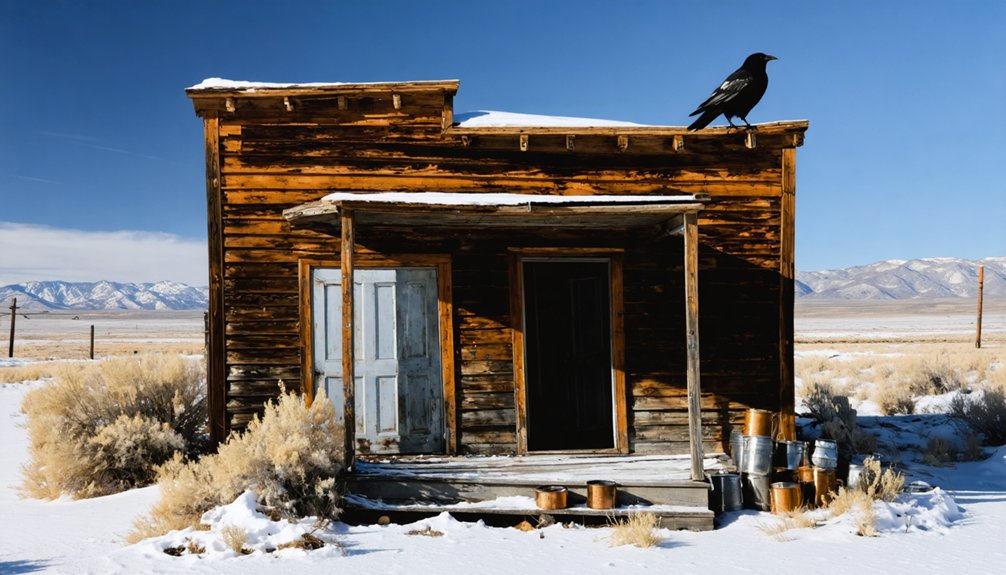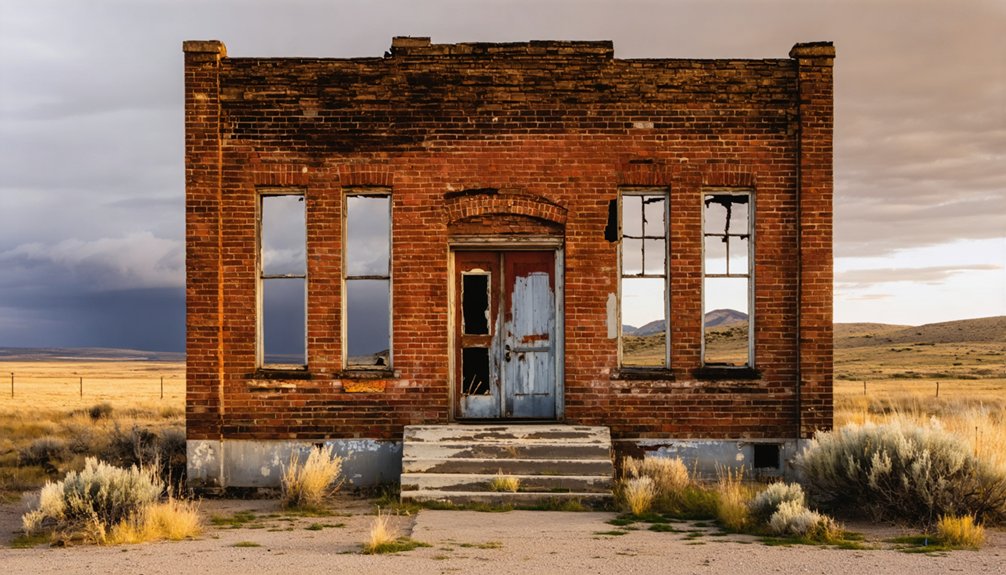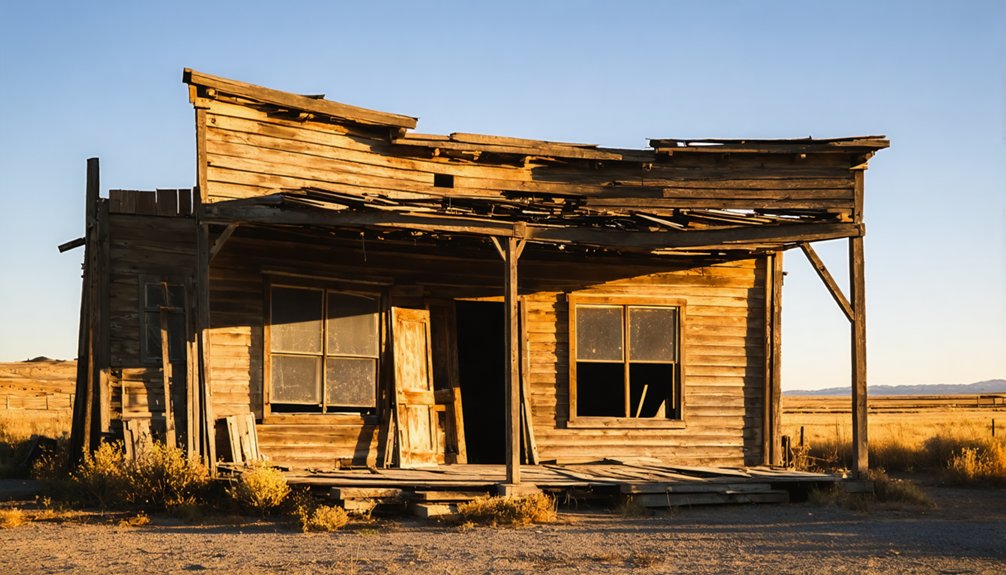You’ll find Pioneerville nestled in Idaho’s historic Boise Basin, where gold’s discovery in 1862 transformed it into a bustling boomtown of 3,000 residents by 1863. Miners earned up to $200 daily during peak times, while the town supported schools, merchants, and families. Today, weathered wooden structures and mining remnants tell tales of its glory days, though conflicts with Native Americans and declining gold yields eventually led to its abandonment. The ghost town’s preserved ruins hold countless stories of frontier life.
Key Takeaways
- Pioneerville became Idaho’s third-largest mining settlement with 3,000 residents during the 1863 gold rush peak.
- Miners earned up to $200 daily from rich placer deposits before the town’s decline in the late 1860s.
- The town featured mining operations, a post office, schools, and churches before its transformation into a ghost town.
- Remnants include weathered wooden structures, a historic cemetery, hydraulic elevator foundations, and an original smelter site.
- Pioneerville’s abandonment occurred gradually due to depleted gold deposits rather than sudden disasters or catastrophes.
The Birth of a Boise Basin Boomtown
By 1863, you would’ve witnessed nearly 3,000 people calling Pioneerville home, making it the third-largest settlement in the basin.
Like winter mining restrictions, placer operations in the area faced significant seasonal challenges that impacted gold production.
The town’s Pioneerville architecture reflected its rapid growth, with hastily constructed buildings housing essential businesses and mining operations.
As miners wielded their mining tools in search of placer gold, the settlement grew increasingly prosperous, contributing to the Boise Basin’s reputation as the Pacific Northwest’s richest gold region.
The introduction of hydraulic elevators in the 1880s helped sustain mining operations as the town fought to maintain its golden prosperity.
Gold Rush Glory Days: 1862-1863
When George Grimes and Moses Splawn discovered gold in the Boise Basin on August 2, 1862, they sparked one of the Pacific Northwest’s most significant gold rushes.
Despite Grimes’ tragic death shortly after the discovery, word spread quickly, and you’d have found thousands of fortune seekers pouring into the area by winter.
The mining techniques initially focused on placer claims, where you could earn $8 to $20 daily, with some lucky miners striking $200.
By September 1863, Pioneerville’s population had swelled to 3,000, making it the basin’s third-largest settlement.
You’d have witnessed a bustling boomtown economy, though daily life wasn’t easy. Miners faced harsh winters, Indian conflicts, and fierce claim rivalries. The town, originally called Fort Hogem, was officially renamed Pioneer City in 1864.
Transportation to the area relied on steamers to Umatilla before continuing by stage lines and pack-trains.
Still, the Boise Basin became America’s richest gold strike, with its mining camps forever reshaping Idaho’s destiny.
Life in Early Pioneerville
You’d find daily life in early Pioneerville pulsing with the rhythms of mining work, as crews labored around the clock when water levels permitted profitable placer mining.
The town’s social fabric wove together a diverse population of miners, merchants, educators, and families, while courtesans and saloon-keepers added to the characteristic frontier mix.
When not working claims, residents gathered for community activities, though the stark contrasts between “respectable” citizens and rougher elements created an underlying social tension typical of 1860s mining settlements.
The establishment of the post office in 1864 marked a significant milestone in Pioneerville’s development as a proper mining town.
Daily Mining Camp Routines
Life in Pioneerville revolved around the relentless pursuit of gold, with miners rising before dawn to begin their grueling work at the creek beds.
You’d find yourself working long hours with basic tools – pans, sluices, and rockers – hoping to strike it rich in the rushing waters. During peak times, you could earn $8 to $20 daily, with lucky prospectors pulling in up to $200 from prime claims.
After a backbreaking day of mining tasks, you’d head to the bustling camp where saloons and gambling halls offered escape from the daily routines.
You’d swap tales of strikes and misses with fellow miners while dealing with the harsh realities of crowded conditions, disease, and limited amenities.
When winter came, survival became your primary concern as you faced the bitter Idaho elements.
Ethnic and Social Diversity
By September 1863, Pioneerville had grown into the third-largest mining camp in the Boise Basin, boasting a diverse population of nearly 3,000 residents.
You’d have encountered miners from Mexico, Canada, Great Britain, Italy, France, China, and even the Hawaiian Islands, each group forming their own ethnic networks while contributing to the camp’s cultural blending.
The social structure included merchants, lawyers, and laborers, with opportunities for advancement if you struck it rich.
While specific details about Pioneerville’s cultural institutions are scarce, you would’ve found the post office serving as an essential community hub.
Like many mining communities, Pioneerville exhibited a mix of lawlessness and community.
The name “Hogem” emerged when early prospectors grew frustrated with miners who were hogging good placer.
Entertainment and Community Activities
Despite the hard work of mining life, early Pioneerville settlers found ways to pass their leisure hours through informal gatherings and entertainment. You’d have found miners congregating in the town’s saloons, sharing stories of their latest strikes and engaging in card games after long days of physical labor. Many residents documented their experiences through the ghost town galleries that still exist today.
While there weren’t any dedicated theaters or community halls like those in nearby Idaho City, social gatherings often centered around seasonal events. During harsh winters, when mining activities slowed, you’d notice increased community celebrations as residents relied more heavily on each other. The winter of 1864-65 was particularly challenging as impassable roads prevented supplies from reaching the mining communities.
These gatherings likely mirrored the festivities of neighboring Idaho City, with picnics and patriotic parades marking special occasions. However, as the gold played out and the population dwindled in the late 1860s, these community activities gradually disappeared from Pioneerville’s social landscape.
Mining Operations and Technology

When gold was first discovered in Pioneerville in 1862, miners initially focused on placer mining techniques that yielded impressive returns, with some prospectors collecting up to $200 per day.
You’ll find that mining innovations rapidly evolved as surface deposits were depleted. By the 1880s, technological advancements like hydraulic elevators, operated by pioneers such as Ben Willson, allowed miners to process lower-grade ore deposits effectively.
Mining evolved beyond simple surface extraction, with innovations like hydraulic elevators enabling efficient processing of less profitable deposits.
As placer mining declined in the late 1860s, you’d see operations shift toward lode mining, with at least 10 quartz mills processing free-milling gold ores. Notable mines like the Elkhorn produced $800,000 by 1868.
Though a silver smelter was built in 1869 to diversify operations, it wasn’t successful, and Pioneerville’s mining productivity gradually diminished despite continued small-scale placer mining.
The Battle for Survival: Native American Conflicts
The discovery of gold in Pioneerville and the broader Boise Basin sparked devastating conflicts between Native American tribes and the influx of miners arriving in 1862.
As you explore this ghost town’s history, you’ll find that the area became a focal point of Native resistance against the overwhelming tide of prospectors who violated existing tribal treaties and territories.
The region’s tribes, including the Shoshone, Paiute, Bannock, and Nez Perce, fought to protect their ancestral lands during the Snake War (1864-1868) and subsequent conflicts. The extensive guerrilla skirmishes stretched across five states as Native Americans defended their traditional hunting grounds.
You’ll discover that military campaigns, including the tragic Bear River Massacre where over 250 Shoshone perished, ultimately forced Native peoples onto reservations.
The mining boom’s dark legacy includes the displacement of indigenous communities who’d called this land home for generations.
Notable Characters and Social Dynamics

Life in Pioneerville extended far beyond its violent territorial conflicts, shaping a vibrant community of nearly 3,000 residents by September 1863. Notable individuals like Miss Jennie Arlington, who taught at the public school in 1878, represented the town’s commitment to education and civilization amid the gold rush atmosphere.
You’d have found a clear social hierarchy in Pioneerville, with successful miners and merchants at the top of the economic ladder. While men dominated the population, women carved out essential roles as teachers, homemakers, and business proprietors.
Despite the town’s rough-and-tumble reputation, families put down roots, sending their children to school and establishing permanent homes. The community’s social fabric, though fluid due to the transient nature of mining life, supported churches, schools, and regular gatherings.
Economic Peaks and Valleys
During Pioneerville’s early boom period, you’d find miners earning up to $2,000 per week in the richest placer deposits, though such exceptional yields were rare and short-lived.
As surface gold became scarce by the late 1860s, mining operations turned to more expensive hydraulic methods, requiring substantial investment in equipment and water systems.
These hydraulic ventures attempted to sustain the town’s mining economy, but the returns couldn’t match the extraordinary profits of the early placer mining days.
Daily Mining Income Figures
Mining profits in Pioneerville initially soared after George Grimes and Moses Splawn’s 1862 gold discovery, with early prospectors extracting an impressive $2,000 in their first week of operations.
You’ll find that daily earnings for most miners ranged from $8 to $20, though some lucky prospectors struck it rich, pulling in $100 to $200 per day during peak times.
Mining profitability drove the town’s explosive growth, attracting thousands of fortune seekers who worked claims around the clock when water was available.
By 1863, Pioneerville had become the third-largest mining camp in Boise Basin, though this prosperity wouldn’t last.
The late 1860s saw sharp declines in placer yields, and while a silver smelter and hydraulic elevators attempted to revive the town’s fortunes in later years, they never matched the early gold rush‘s spectacular returns.
Hydraulic Mining Investment Returns
The financial tide of Pioneerville shifted dramatically with the advent of hydraulic mining in the 1880s. You’d have seen investment strategies evolve from traditional placer operations to hydraulic elevators, offering a lifeline to the town’s declining gold industry.
While initial investments were lower than costly stamp mills, these operations delivered quicker returns and extended mining life beyond the surface-level deposits.
Mining profitability experienced distinct peaks and valleys. You could’ve witnessed successful reprocessing of previously “worked out” gravels creating a secondary economic surge, but environmental constraints eventually caught up.
Limited tailings space and seasonal water availability created boom-bust cycles, while failed attempts at diversification through silver smelting highlighted the town’s economic vulnerability.
The Slow Fade Into Ghost Town Status

Although Pioneerville once thrived as Idaho’s third-largest Boise Basin settlement with 3,000 residents in 1863, its transformation into a ghost town unfolded gradually through the late 19th century.
You’ll find that unlike some mining towns destroyed by disasters, Pioneerville’s decline stemmed from its inability to achieve community resilience when the placer gold deposits ran dry.
The town’s attempts at economic diversification, including a silver smelter and hydraulic mining operations in the 1880s, couldn’t sustain the population.
As mining profitability waned, residents departed for better opportunities, leaving behind deteriorating wooden buildings and minimal services.
What Remains: Modern Day Remnants
Scattered across Pioneerville’s forested landscape at 4,439 feet elevation, you’ll find weathered wooden structures and mining remnants that tell the story of Idaho’s once-thriving Boise Basin settlement.
Time stands still in Pioneerville, where weathered buildings and mining relics whisper tales of Idaho’s golden past.
Among the remaining structures, the area’s first post office still stands, alongside a few pioneer-era cabins and deteriorating mill ruins.
Today’s ghost town offers these notable features:
- Historic cemetery with 19th-century tombstones
- Hydraulic elevator foundations from 1880s mining operations
- Visible tailings and mine shafts marking the hillsides
- Original smelter site with scattered mining artifacts
While much of the site lies on private property, you can still explore portions of this abandoned mining town.
Nature’s steady reclamation continues as vegetation embraces the ruins, while seasonal weather gradually wears away at these silent witnesses to Idaho’s gold rush era.
Legacy of a Lost Mining Settlement
When you visit Pioneerville today, you’ll find a mining legacy that helped shape Idaho’s early development as a territory and eventual state.
The town’s role as the third-largest settlement in the Boise Basin during the 1860s established vital economic and social foundations that influenced the broader region’s growth.
While few physical structures remain, the site preserves important archaeological evidence of 19th-century mining techniques, Chinese immigrant contributions, and the dramatic impact of the Western gold rush era on America’s mining frontier.
Preserving Mining Site Remains
Despite the passage of time, Pioneerville’s mining legacy endures through its surviving wooden structures and industrial remnants at 4,439 feet elevation.
Historic preservation efforts focus on protecting these tangible links to Idaho’s mining era, though harsh weather and limited resources pose significant archaeological challenges.
You’ll find these key preservation activities at the site:
- Stabilization of original smelter facilities and wood-frame buildings
- Documentation through 1880s maps and archival records
- Conservation of hydraulic elevator equipment and mining artifacts
- Archaeological mapping of placer claims and mine shafts
The Idaho State Historical Society, alongside local heritage groups, continues to research and protect these valuable remains.
Through their work, you can still explore authentic remnants of this once-bustling mining settlement, though many structures remain in fragile condition.
Cultural Impact Today
The enduring legacy of Pioneerville extends far beyond its crumbling structures and weathered mining remnants.
You’ll find its influence woven into the broader narrative of Idaho’s mining heritage, though the town’s direct cultural footprint has largely faded into obscurity.
While you won’t discover any museums or festivals specifically dedicated to Pioneerville today, its story lives on through ghost town tourism and regional mining lore.
The settlement’s rapid rise and fall serve as a compelling reflection of the American West’s boom-and-bust cycles, even if detailed records of daily life remain scarce.
You can still trace its impact in persistent placer mining claims and the enduring cultural memory of the Boise Basin’s golden age.
Frequently Asked Questions
Are There Any Paranormal or Supernatural Stories Associated With Pioneerville?
You won’t find documented ghost sightings or haunted locations in Pioneerville’s history. Despite its status as a ghost town, no specific supernatural stories have been officially recorded from this mining camp.
Can Visitors Legally Collect Artifacts or Gold From the Site?
You can’t legally collect artifacts or gold without proper permits and authorization. Mining regulations and artifact preservation laws protect the site, requiring permission from landowners or managing agencies before any collection.
What Happened to the Town’s Cemetery and Where Was It Located?
You’ll find the cemetery about a mile from Pioneerville’s main townsite, across from a residence. It’s largely unmaintained now, reflecting burial practices of the mining era, with many graves likely unmarked.
Did Pioneerville Have Its Own Newspaper During the Boom Years?
While 43 Idaho towns had newspapers in the 1800s, you won’t find evidence of Pioneerville journalism having its own dedicated paper. Instead, you’ll see the town’s news covered by Idaho City’s newspapers.
Were There Any Major Fires or Natural Disasters in Pioneerville?
You won’t find any major documented fire incidents or natural disaster impact in Pioneerville’s records, unlike nearby Idaho City which suffered multiple devastating fires during the same mining period.
References
- https://yellowpinetimes.wordpress.com/2024/03/31/idaho-history-mar-31-2024/
- https://westernmininghistory.com/towns/idaho/pioneerville/
- https://history.idaho.gov/wp-content/uploads/2018/12/0166.pdf
- https://www.legendsofamerica.com/idaho-city-idaho/
- https://idgenweb.org/archives/history-ghost+towns.html
- https://www.ghosttowns.com/states/id/pioneerville.html
- http://www.ghosttowngallery.com/htme/pioneerville.htm
- https://visitidaho.org/things-to-do/ghost-towns-mining-history/idaho-city-historical-area/
- https://westernmininghistory.com/towns/idaho/placerville/
- https://yellowpinetimes.wordpress.com/2024/05/12/idaho-history-may-12-2024/



